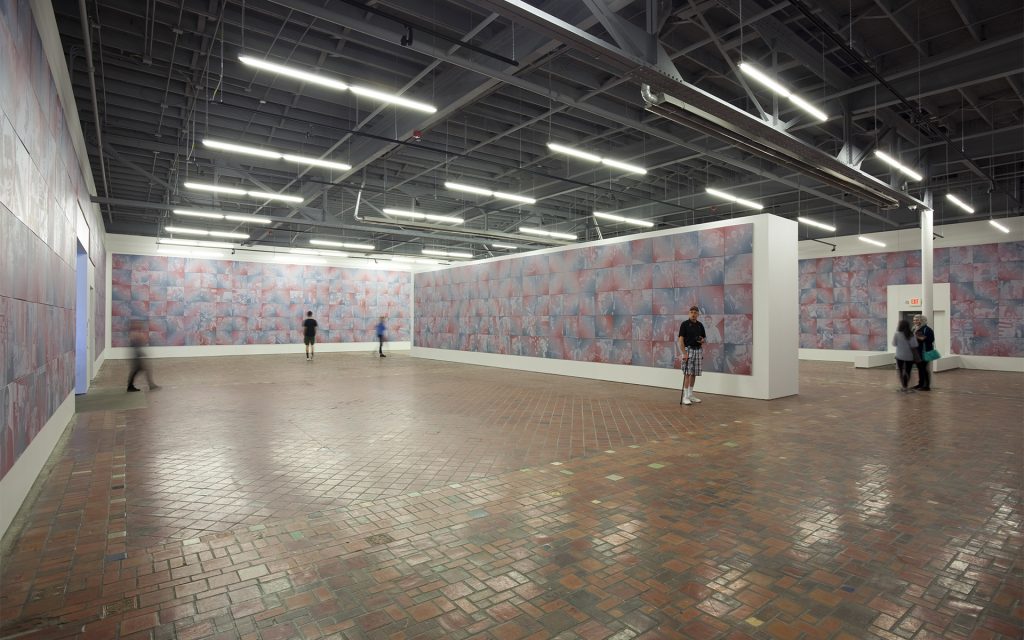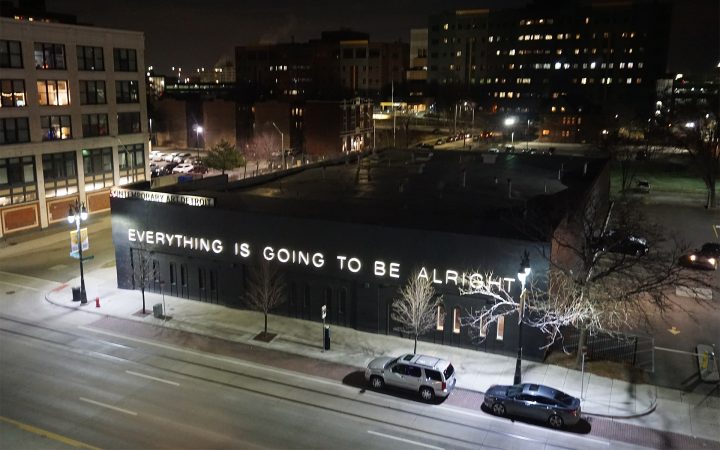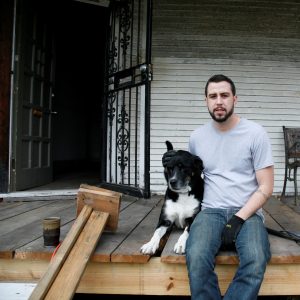Hanging over the Detroit Industry Murals— perhaps the piece of art that best represents Detroit during the 20th century— located in the Detroit Institute to Arts, unquestionably one of the most important art museums in the U.S., is a quote etched in stone.
“Ars longa, vita brevis,” it reads in Latin.
In English, “Life is short. Art is long.”

EDDIE MARTINEZ MOCAD INSTALLATION VIEW LEFT TO RIGHT: FORMAL, 2018-2019, UNTITLED, 2019. PHOTO TIM JOHNSON
It was first written by Hippocrates, considered to be the father of medicine, somewhat ironic that a physician might be speaking of the timelessness of art. It’s doubly ironic during a time of plague.
While the heroes of this pandemic are the healthcare workers, the grocery store stockers, the bus drivers, people that have to brave this invisible disease every day, it is artists who will help us to understand this crisis in the future, help us to imagine a new world after it, and comfort, reassure, and offer us stimulating release in the meantime.
In the 21st century, and during COVID-19, art is still long. It will outlive all of us, and it will outlive this plague. But, like many others in precarious financial positions, the terror and economic catastrophe of this crisis are clawing at the ability of artists to make a living, survive, and ultimately make art, those messages that will live beyond us, plague or not.
THE MESSAGE ART CONVEYS
To help artists survive during financially lean and scary times, the Museum of Contemporary Art Detroit has come up with a novel piece to the economic puzzle in supporting artists and has partnered with the Detroit Office of Arts, Culture and Entrepreneurship to do so.
They are holding a sale of works from artists primarily from Detroit but hailing from all over the country that will benefit the artists and museum at a 50/50 split. Most pieces are priced between $1,000 and $5,000, with at least 64 artists currently participating.
“Art is always a reflection of what’s happening culturally, politically, economically; artists, especially contemporary artists are always asking the big questions about who we are as a culture, who we are as a people, who we are as a globe,” said Wayne Northcross, membership manager at MOCAD. “Without art, the conversations around those issues are diminished.”
He stressed that in many ways artists offer meaning, answers, and perhaps most importantly, ask the right questions during uncertain times. Without financial support to the arts and artists, our culture and society is impoverished, he said. Who would perform as the nation’s conscience, it’s guidelight, it’s mirror, without the arts?
“Artists are workers, are producers, and they also need to sell and to make money, and I think [this fundraiser] is a way to support that,” he added. “There is no culture without art.”
In short, the ability of artists— already often economically insecure— to feed themselves, thrive, and make art during crises such as this affects the quality of the stories we tell about it now and in the future, what we remember about this plague as a species, and how we improve ourselves as a society.
Ricky Weaver, an artist from Ypsilanti participating in the MOCAD art fundraiser, offered a quote from Frantz Fanon, the legendary french-language philosopher from Martinique, to sum up art’s role in the world.
“A man who has a language consequently possesses the world expressed and implied by that language.”
“If we can only think in terms of the language we already have,” she said, by way of explanation, “we can’t really think of something completely new.”
Artists create that language. Not only do artists reflect and reflect-on the reality of the times, but they help us to envision new ones. Or, as Brecht, the great German dramatist put it, “art is not a mirror to reflect reality, but a hammer with which to shape it.”
“[As artists] we’re building languages through art, images, text, we’re worldbuilders,” Weaver said. “We’re thinking about the things going on, we’re processing them… that archive of images text and work is being disseminated and I really do feel like it changes the world.”
Ryan Standfest, an artist living in Detroit and also participating in the sale, agreed one of the most important roles of art during times like these is to not only to explain the present or near past, but to turn times of crisis into opportunity and build the future.
ART IN THE TIME OF CRISIS
“With a crisis comes this opportunity to recalibrate, and that calibration leads to very unique solutions,” he said. “Artists in Detroit— people in Detroit, period— have had stuff thrown at them for decades, and there’s a way to rethink the model.”

ROB PRUITT THE OBAMA PAINTINGS AND THE LINCOLN MEMORIAL, INSTALLATION VIEW, 2015. PHOTO MOCAD
Standfest said art can ask for a reimagining of the world both in the broad sense of what art and society can and should accomplish— say, the necessity of universal healthcare in time of plague— but also in the short term economically. He runs a small press called Rotland Press, and said he was attempting to deliver his product in a new way due to the pandemic, by releasing it without cost at first and monetizing it later.
He emphasized the emotive and communicative nature of art, especially when those in society are physically separated from one another.
“In a time like this where we’re all self-isolating, communication is really important, and art is another form of communication: how am I feeling right now? What am I thinking right now? What do I have to say politically? What do I have to say about my community?” He said. “This could be a kind of clarion call, a wake-up.”
Artist Rachel Thomas stressed the quotidian and comforting aspects of art during uncertain times. All those Netflix shows, the films, the books, the video games, the virtual museum tours, the live-concerts-from-home getting us through this quarantine, they were all created by artists.
“Art is a source of inspiration, it helps get your mind off things, it’s enjoyment, it’s fulfillment,” she said. “After quarantine we need to continue supporting the arts… there’s history involved. These spaces, these museums, these local galleries, they’re here for us.”
Like other artists, she said, her income has been devastated by the crisis, both in teaching contracts and in exhibitions that have been delayed or canceled. What happens now economically will determine her ability to make art— and pose these conversations, these new worlds, these fonts of comfort— in the near future.
Elyse Foltyn, chair of the MOCAD board, said Detroit, as one of the epicenters of viral spread and a city that is no stranger to hard times, offers some lessons on resilience, and creative fundraising, in times of crisis.
“Art is a great way for people to get past their fears, to explore their own feelings, and express their resilience and the human spirit,” she said. ”Historically MOCAD has played a really important part in healing and getting past struggles and enabling people to move forward and do something even as things appear bleak.”
“Art can help us through the most frightening and bleak periods. Historically it provides assurance that we will get through this,” Foltyn said. “And in fact when we get through this we’ll become stronger as a community, a nation as individuals. We’ll come out even stronger.”























